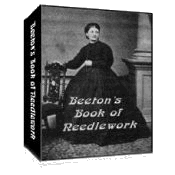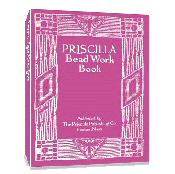BERLIN WORK
Berlin Work is a style of canvas work embroidery. In the 1830's, a new process of dyeing wools made this type of embroidery possible. The resulting embroidery produced very durable and long lasting pieces. It was generally used to create cushions, bags and furniture covers although at the height of its popularity, it was used for almost anything - mantel lambrequins to personal accessories.
Designs that were popular were landscapes, floral motifs and domestic animals - usually dogs, cats and parrots. The Last Supper was also a very popular theme.
HISTORY
Berlin Work was named after the city in which it was introduced, Berlin, German. In the beginning, patterns were printed in black and white and then hand-colored. It did not take long for the patterns to be printed in color on charted paper much like today's cross-stitch patterns. The ease of translating the designs and colors by the embroiderer made this type of embroidery very popular. Patterns were soon exported to Great Britain and the United States where its popularity soared.
The decline of this type of needlecraft's popularity began in the 1850's through 1870's due to publishers' failure to accommodate embroiderers and their new tastes in designs.
BERLIN WOOL WORK
Today, this type of embroidery work is available, usually in kits. The patterns are now printed in color on the canvas itself instead of paper as before.
Motifs from the 19th century are still used but are generally not as detailed as once were. Kits typically contain a preprinted canvas, needle, wool or yarn, and easy to follow instructions.
INSTRUCTIONS
Berlin Work includes every kind of stitch that is made upon canvas with wool, silk, or beads. The principal stitches used are common Cross-stitch, Gobelin stitch, Leviathan stitch, Raised or Velvet stitch, Tent stitch, and others. The materials and needle must always be carefully chosen of a corresponding size.
Before beginning to work upon a piece of canvas the raw edges must be hemmed or sewn over to prevent raveling. Many embroiderers prefer to use masking tape to prevent fraying. It's faster and works just as well.
Care must be taken not to crumple the canvas in the course of the work. This type of work should always be worked in a frame. When you undertake to work a large pattern begin in the center, and complete one half before you commence the other. Always work the stitches in the same direction, from the top downwards - this is very essential to the beauty and regularity of the pattern.
Complete the pattern first. When the pattern is finished, begin the grounding. Care must be taken that the wool not be drawn too tightly, otherwise the threads of the canvas will appear.
Return to top of page.
Return to Types of Embroidery page.
Return from Berlin Work to Home.



 433 pages!
433 pages!

